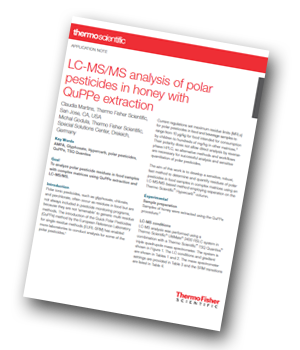Thermo Fisher Scientific has produced an application note describing the analysis of polar pesticide residues in food samples with complex matrices using QuPPe (Quick Polar Pesticides) extraction and LC-MS/MS.
 Introduction
Introduction
Polar ionic pesticides, such as glyphosate, chlorate, and perchlorate, often occur as residues in food but are not always included in pesticide monitoring programs, because they are not ‘amenable’ to generic multi-residue methods. The introduction of the Quick Polar Pesticides (QuPPe) method by the European Reference Laboratory for single residue methods (EURL-SRM) has enabled more laboratories to conduct analysis for some of the polar pesticides.
The aim of this work is to develop a sensitive, robust, fast method to determine and quantify residues of polar pesticides in food samples in complex matrices using an LC-MS/MS-based method employing separation on the Thermo Scientific™ Hypercarb™ column.
Experimental
Samples of honey were extracted using the QuPPe procedure. LC-MS analysis was performed using a Thermo Scientific™ UltiMate™ 3400 RSLC system in combination with a Thermo Scientific™ TSQ Quantiva™ triple quadrupole mass spectrometer.
Results and Conclusion
This study reported has demonstrated the applicability of the TSQ Quantiva LC-MS/MS system to analyse the QuPPe method extracts in complex matrices, such as honey, at the required regulatory levels. In addition to the easily achieved LOQs, the study demonstrated robustness of the system, allowing uninterrupted analysis of up to 500 honey samples and easy cleaning of the ion introduction system.




